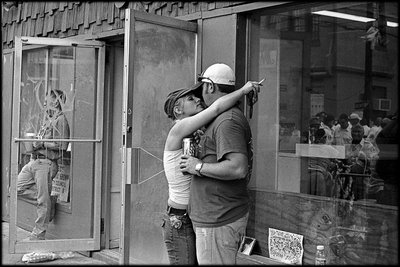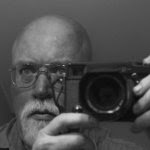The 50mm Heliar - An Old Design That's Still Superb
As lens designs go, the Heliar is positively retro. A very simple lens designed in 1900 by Hans Harting of Voigtländer, the first Heliar consisted of five elements with cemented doublets on the front and back. The first few samples had problems with astigmatism and heavy coma. In 1903, Harting changed the sequence such that the three concave elements were surrounded by an outer and an inner convex element, an idea that he may have borrowed from the earlier Tessar. This third design, named the Dynar, is similar to the today’s Voigtländer Heliar.
Voigtländer’s 50/3.5 Heliar has everything that I could possibly wish for in a lens with the exception of speed. But with lens speed comes greater size and weight, and lenses designed primarily for speed generally don’t stack up as well as slower lenses in daylight shooting at medium apertures. What do I like in a lens?
The “normal” focal length of 40-55mm. I am occasionally ribbed on forums for allegedly having more normal lenses than anyone else. Why do I do like normal lenses so much? They are invariably less expensive than longer or shorter focal lengths, they can be relatively fast despite being in a small package, they are less likely to produce the distortion associated with wide angle lenses, and they are easier to focus accurately than are telephoto lenses. And they produce images that look “normal”, i.e., like my eyes perceive the subject. By the way, I have four 50/3.5 Cosina-Voigtländer Heliars in my collection of normal lenses.
- Sharpness from center to edge. Most lenses perform best in their center, with resolution falling off at the edges. A well-designed lens should be sharp from center to edge.
- Sharpness wide open. Even a very old or crudely-designed lens can perform fairly well when stopped down to f/8. But if you want to keep your subject in focus and the rest of the picture soft, you have to shoot wide open.
- Even contrast from center to edge. Like resolution, contrast tends to be higher in the middle, and drops off at the edges.
- Even brightness from center to edge. Ultra-wide lenses are notorious for vignetting, and the effect is even worse when you get blue sky in the image at the upper corners. A good lens should not have a hot spot in the center.
- Long tonal scale. When color film became the favored medium of professional photographers, lens design was optimized for color. What increased color saturation also increased contrast and decreased tonal scale. I prefer black and white photography, and I try to find films, developers, and lenses that give me a long tonal scale. Sometimes that means buying 50-year-old lenses. Recently, Cosina obliged people like me and released a 40/1.4 Nokton that was single-coated. The raison d'être for that lens is increased tonal scale.
- Smooth bokeh. Virtually nobody in the Western World talked about bokeh by name two decades ago, and you will have difficulty finding a definition for it in a modern dictionary or encyclopedia. Bokeh is the rendering of out-of-focus areas of a photograph. While I don’t think that lovely bokeh will make or break a photograph, I do think that ugly, distracting, or idiosyncratic bokeh will ruin an otherwise excellent photograph. Bokeh from mirror lenses is the worst, changing point sources of light into bright circles. Bokeh from modern, aspherical lenses can be distracting, with sources of light showing up as crescents or round, wafer-like objects, some with double-lines. At worst, it can look like an out-of-focus fireworks display in the background. When it is at its best, it is not at all distracting and serves to give the image a three-dimensional feel.
- Resistance to flare. I frequently observe posters on forums singing the virtues of a particular lens only to conclude with the regrettable caveat that flare is a problem.
Two versions of the Voigtländer 50/3.5 Heliar have been produced, and both were produced in relatively small numbers in limited-edition sets. The earlier version was a collapsible silver lens in Leica thread mount. A newer version that is still available from some vendors is a rigid lens in Nikon rangefinder mount. Both lenses are very small and very lightweight. They are the same optical design and perform equally well. Like Nikon rangefinder lenses, the aperture scale rotates when the lens is focused. It should take most shooters only a few minutes to adjust to this.
Cosina released the first Bessa R2S Nikon-compatible rangefinder body in 2001, along with a similar Contax-compatible rangefinder body, the R2C. Cosina produced no lens line for the Contax-compatible body, but did release a full complement of modern Voigtländer lenses in Nikon-compatible mounts. This was great news for Nikon users as Nikon rangefinder lenses in excellent condition are in short supply due to being coveted by collectors. At the time Cosina started production of the Nikon-mount lenses, my collection of Nikon-mount lenses consisted of two 50/1.4 lenses in non-collectible condition. Thanks to Cosina, Nikon RF users now had access to very high-performing multicoated lenses, two of them aspherical models. And Cosina appears to have taken special efforts to design these lenses to resemble their Nikon counterparts. I eventually invested in four of the focal lengths I use routinely, from 21 to 50mm. The 21 and 28 are exceptionally compact.
The Voigtländer R2S and 50/3.5 Heliar is my favorite camera/lens combination. My left index finger rests naturally under the aperture ring, steadying the front of the lens, and my right index finger moves naturally to the focusing wheel in front of the shutter release. This allows fine-tuning both aperture and focus without having to move either hand. And with the trigger winder attached below, I can advance the film without having to move either hand or my eye from the back of the camera. Those who are familiar with Nikon rangefinders are aware that the focusing helical is in the camera body, not the lens. This means that the entire lens moves during focusing. Those accustomed to Leica rangefinders invariably find themselves inadvertently changing the focus slightly when changing aperture. I have not had problems with this while shooting with the R2S; the aperture ring does not have click-stops and moves very smoothly and effortlessly when changing aperture. My right index finger resting on the focusing wheel serves as a brake to prevent losing my focus. The Heliar controls flare very well, a must in street shooting where one doesn’t have control over the lighting. The front element is recessed within a deep lens hood. Bright point-sources of light (such as reflections of the sun from a polished automobile) are well-controlled as small, 10-spiked stars of light.
The shot below was taken with a Nikon-mount 50/3.5 Heliar on a Bessa R2S. The lens excels in color and B&W work. It is probably the best all-around lens I have.

The image below was taken on a very bright, dry, cloudless day. The Heliar kept the flare down to small stars. Overall contrast of the image was not compromised by the bright point sources of light from the sun.

Photographers are often asked if they would replace a certain body or lens if it were lost or stolen. That is not an option for the collapsible LTM-mount Heliar as they are no longer available new. And this won’t be an option for long with the NHS R2S Heliar Limited Edition as it was produced in small numbers and relatively few are left. That’s why I have four Heliars…what if something happened to three of them?


<< Home